Audit Expectation Gap and Threats to Audit Independence in Australia
VerifiedAdded on 2022/10/12
|10
|1815
|99
AI Summary
This article discusses the audit expectation gap and threats to audit independence in Australia, with a focus on the audit engagement of Bletchington Limited. It covers the definition of audit expectation gap, unrealistic expectations of financial statement users, and the responsibilities of auditors. It also discusses the potential threats to audit independence and the safeguards to overcome them.
Contribute Materials
Your contribution can guide someone’s learning journey. Share your
documents today.
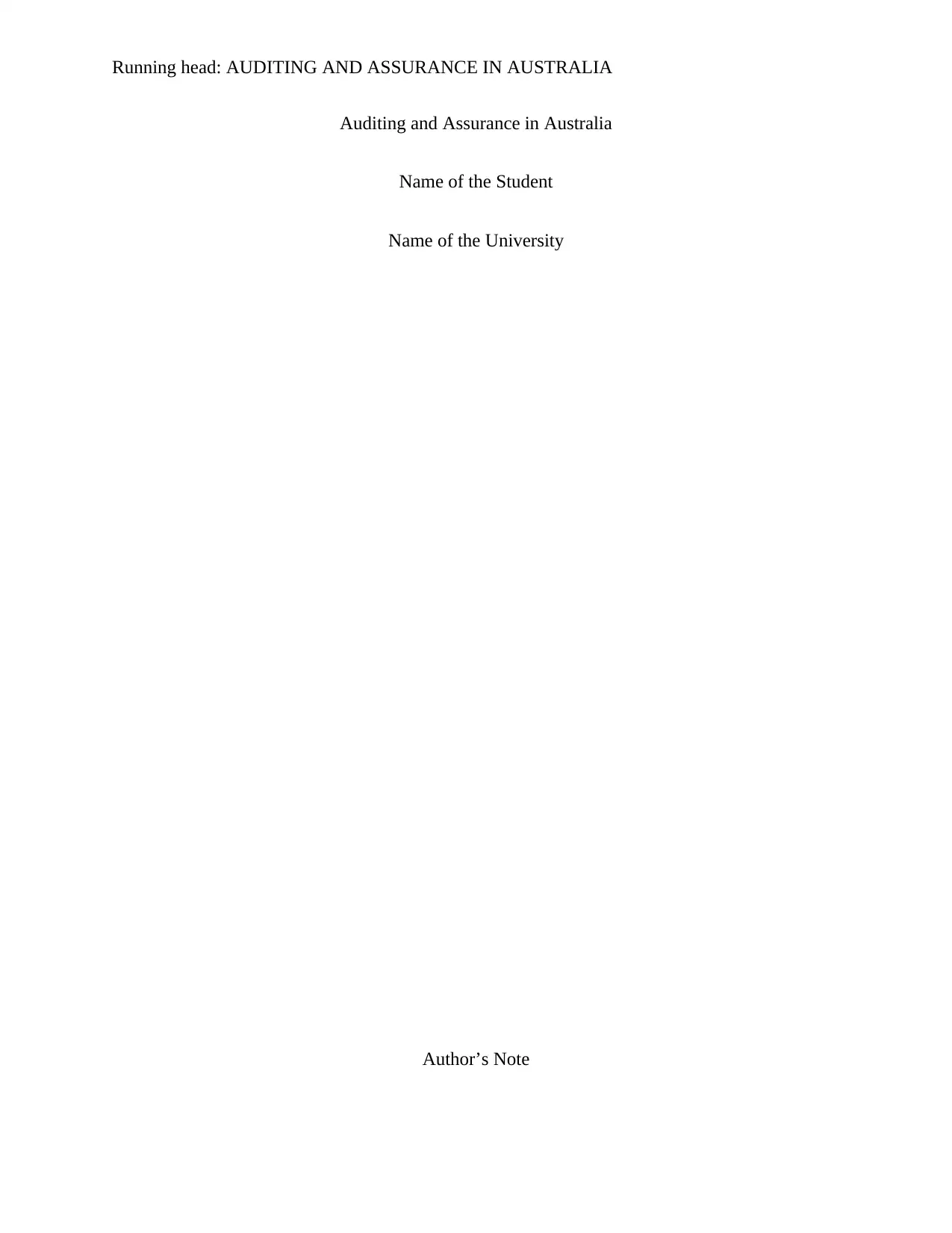
Running head: AUDITING AND ASSURANCE IN AUSTRALIA
Auditing and Assurance in Australia
Name of the Student
Name of the University
Author’s Note
Auditing and Assurance in Australia
Name of the Student
Name of the University
Author’s Note
Secure Best Marks with AI Grader
Need help grading? Try our AI Grader for instant feedback on your assignments.
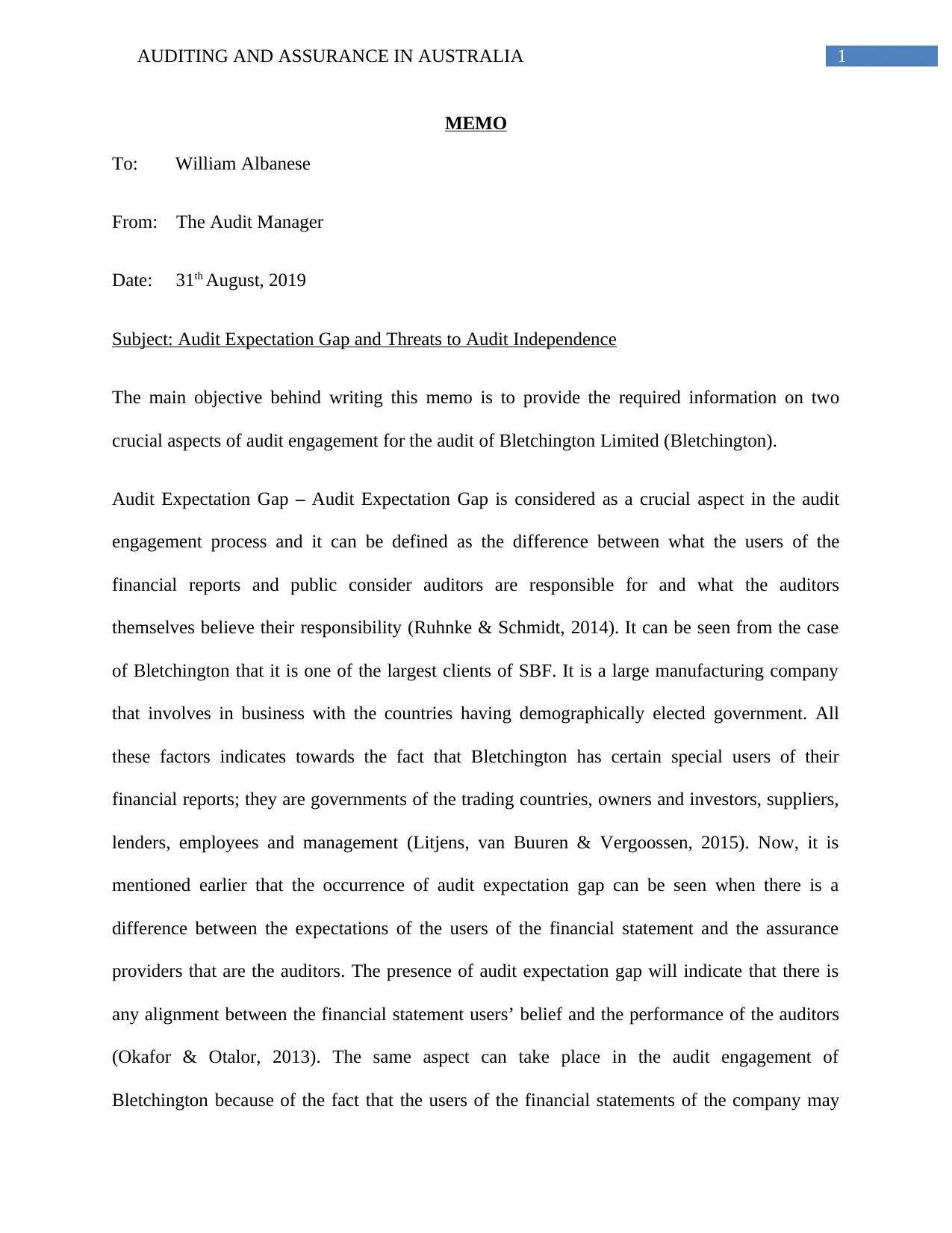
1AUDITING AND ASSURANCE IN AUSTRALIA
MEMO
To: William Albanese
From: The Audit Manager
Date: 31th August, 2019
Subject: Audit Expectation Gap and Threats to Audit Independence
The main objective behind writing this memo is to provide the required information on two
crucial aspects of audit engagement for the audit of Bletchington Limited (Bletchington).
Audit Expectation Gap – Audit Expectation Gap is considered as a crucial aspect in the audit
engagement process and it can be defined as the difference between what the users of the
financial reports and public consider auditors are responsible for and what the auditors
themselves believe their responsibility (Ruhnke & Schmidt, 2014). It can be seen from the case
of Bletchington that it is one of the largest clients of SBF. It is a large manufacturing company
that involves in business with the countries having demographically elected government. All
these factors indicates towards the fact that Bletchington has certain special users of their
financial reports; they are governments of the trading countries, owners and investors, suppliers,
lenders, employees and management (Litjens, van Buuren & Vergoossen, 2015). Now, it is
mentioned earlier that the occurrence of audit expectation gap can be seen when there is a
difference between the expectations of the users of the financial statement and the assurance
providers that are the auditors. The presence of audit expectation gap will indicate that there is
any alignment between the financial statement users’ belief and the performance of the auditors
(Okafor & Otalor, 2013). The same aspect can take place in the audit engagement of
Bletchington because of the fact that the users of the financial statements of the company may
MEMO
To: William Albanese
From: The Audit Manager
Date: 31th August, 2019
Subject: Audit Expectation Gap and Threats to Audit Independence
The main objective behind writing this memo is to provide the required information on two
crucial aspects of audit engagement for the audit of Bletchington Limited (Bletchington).
Audit Expectation Gap – Audit Expectation Gap is considered as a crucial aspect in the audit
engagement process and it can be defined as the difference between what the users of the
financial reports and public consider auditors are responsible for and what the auditors
themselves believe their responsibility (Ruhnke & Schmidt, 2014). It can be seen from the case
of Bletchington that it is one of the largest clients of SBF. It is a large manufacturing company
that involves in business with the countries having demographically elected government. All
these factors indicates towards the fact that Bletchington has certain special users of their
financial reports; they are governments of the trading countries, owners and investors, suppliers,
lenders, employees and management (Litjens, van Buuren & Vergoossen, 2015). Now, it is
mentioned earlier that the occurrence of audit expectation gap can be seen when there is a
difference between the expectations of the users of the financial statement and the assurance
providers that are the auditors. The presence of audit expectation gap will indicate that there is
any alignment between the financial statement users’ belief and the performance of the auditors
(Okafor & Otalor, 2013). The same aspect can take place in the audit engagement of
Bletchington because of the fact that the users of the financial statements of the company may
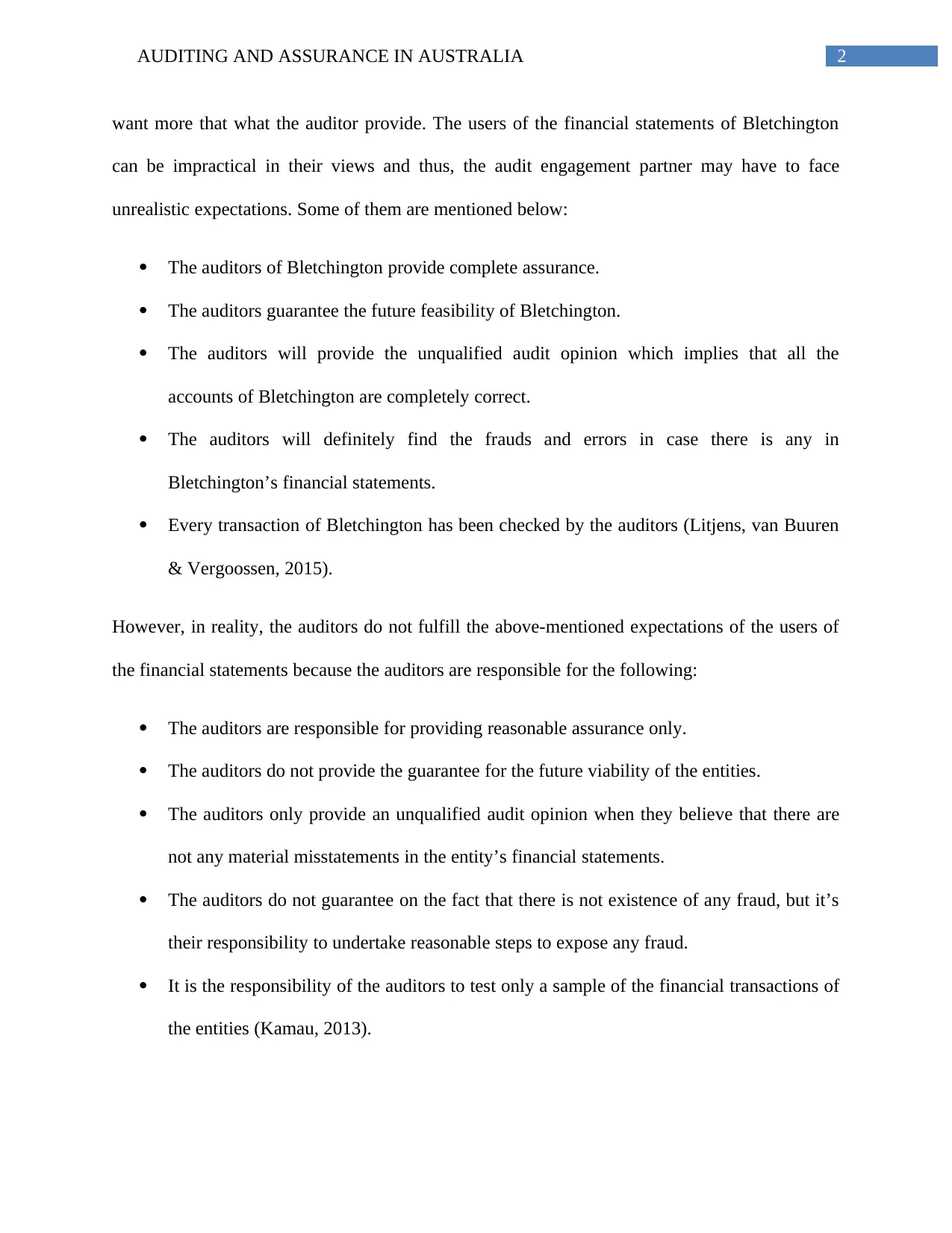
2AUDITING AND ASSURANCE IN AUSTRALIA
want more that what the auditor provide. The users of the financial statements of Bletchington
can be impractical in their views and thus, the audit engagement partner may have to face
unrealistic expectations. Some of them are mentioned below:
The auditors of Bletchington provide complete assurance.
The auditors guarantee the future feasibility of Bletchington.
The auditors will provide the unqualified audit opinion which implies that all the
accounts of Bletchington are completely correct.
The auditors will definitely find the frauds and errors in case there is any in
Bletchington’s financial statements.
Every transaction of Bletchington has been checked by the auditors (Litjens, van Buuren
& Vergoossen, 2015).
However, in reality, the auditors do not fulfill the above-mentioned expectations of the users of
the financial statements because the auditors are responsible for the following:
The auditors are responsible for providing reasonable assurance only.
The auditors do not provide the guarantee for the future viability of the entities.
The auditors only provide an unqualified audit opinion when they believe that there are
not any material misstatements in the entity’s financial statements.
The auditors do not guarantee on the fact that there is not existence of any fraud, but it’s
their responsibility to undertake reasonable steps to expose any fraud.
It is the responsibility of the auditors to test only a sample of the financial transactions of
the entities (Kamau, 2013).
want more that what the auditor provide. The users of the financial statements of Bletchington
can be impractical in their views and thus, the audit engagement partner may have to face
unrealistic expectations. Some of them are mentioned below:
The auditors of Bletchington provide complete assurance.
The auditors guarantee the future feasibility of Bletchington.
The auditors will provide the unqualified audit opinion which implies that all the
accounts of Bletchington are completely correct.
The auditors will definitely find the frauds and errors in case there is any in
Bletchington’s financial statements.
Every transaction of Bletchington has been checked by the auditors (Litjens, van Buuren
& Vergoossen, 2015).
However, in reality, the auditors do not fulfill the above-mentioned expectations of the users of
the financial statements because the auditors are responsible for the following:
The auditors are responsible for providing reasonable assurance only.
The auditors do not provide the guarantee for the future viability of the entities.
The auditors only provide an unqualified audit opinion when they believe that there are
not any material misstatements in the entity’s financial statements.
The auditors do not guarantee on the fact that there is not existence of any fraud, but it’s
their responsibility to undertake reasonable steps to expose any fraud.
It is the responsibility of the auditors to test only a sample of the financial transactions of
the entities (Kamau, 2013).
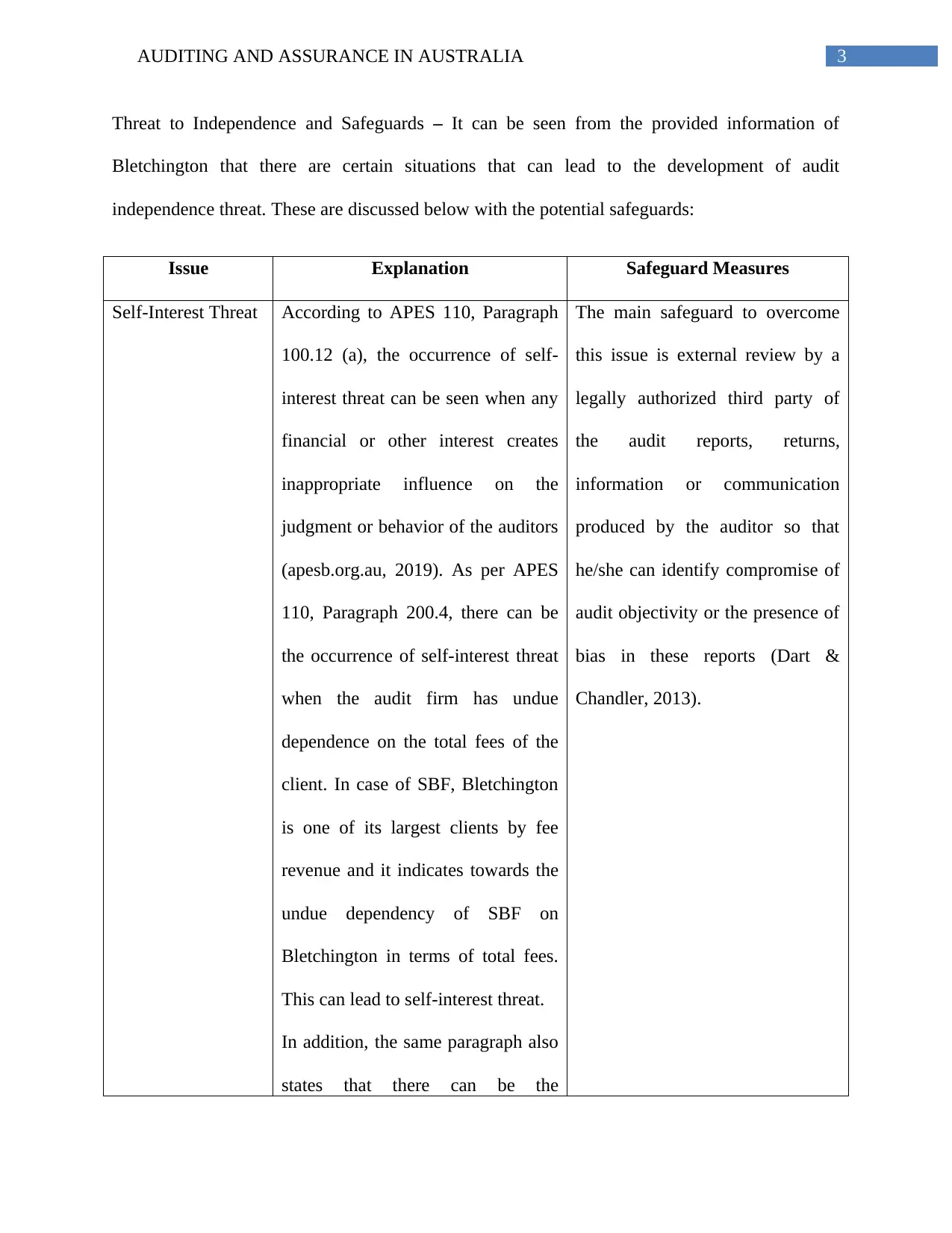
3AUDITING AND ASSURANCE IN AUSTRALIA
Threat to Independence and Safeguards – It can be seen from the provided information of
Bletchington that there are certain situations that can lead to the development of audit
independence threat. These are discussed below with the potential safeguards:
Issue Explanation Safeguard Measures
Self-Interest Threat According to APES 110, Paragraph
100.12 (a), the occurrence of self-
interest threat can be seen when any
financial or other interest creates
inappropriate influence on the
judgment or behavior of the auditors
(apesb.org.au, 2019). As per APES
110, Paragraph 200.4, there can be
the occurrence of self-interest threat
when the audit firm has undue
dependence on the total fees of the
client. In case of SBF, Bletchington
is one of its largest clients by fee
revenue and it indicates towards the
undue dependency of SBF on
Bletchington in terms of total fees.
This can lead to self-interest threat.
In addition, the same paragraph also
states that there can be the
The main safeguard to overcome
this issue is external review by a
legally authorized third party of
the audit reports, returns,
information or communication
produced by the auditor so that
he/she can identify compromise of
audit objectivity or the presence of
bias in these reports (Dart &
Chandler, 2013).
Threat to Independence and Safeguards – It can be seen from the provided information of
Bletchington that there are certain situations that can lead to the development of audit
independence threat. These are discussed below with the potential safeguards:
Issue Explanation Safeguard Measures
Self-Interest Threat According to APES 110, Paragraph
100.12 (a), the occurrence of self-
interest threat can be seen when any
financial or other interest creates
inappropriate influence on the
judgment or behavior of the auditors
(apesb.org.au, 2019). As per APES
110, Paragraph 200.4, there can be
the occurrence of self-interest threat
when the audit firm has undue
dependence on the total fees of the
client. In case of SBF, Bletchington
is one of its largest clients by fee
revenue and it indicates towards the
undue dependency of SBF on
Bletchington in terms of total fees.
This can lead to self-interest threat.
In addition, the same paragraph also
states that there can be the
The main safeguard to overcome
this issue is external review by a
legally authorized third party of
the audit reports, returns,
information or communication
produced by the auditor so that
he/she can identify compromise of
audit objectivity or the presence of
bias in these reports (Dart &
Chandler, 2013).
Secure Best Marks with AI Grader
Need help grading? Try our AI Grader for instant feedback on your assignments.
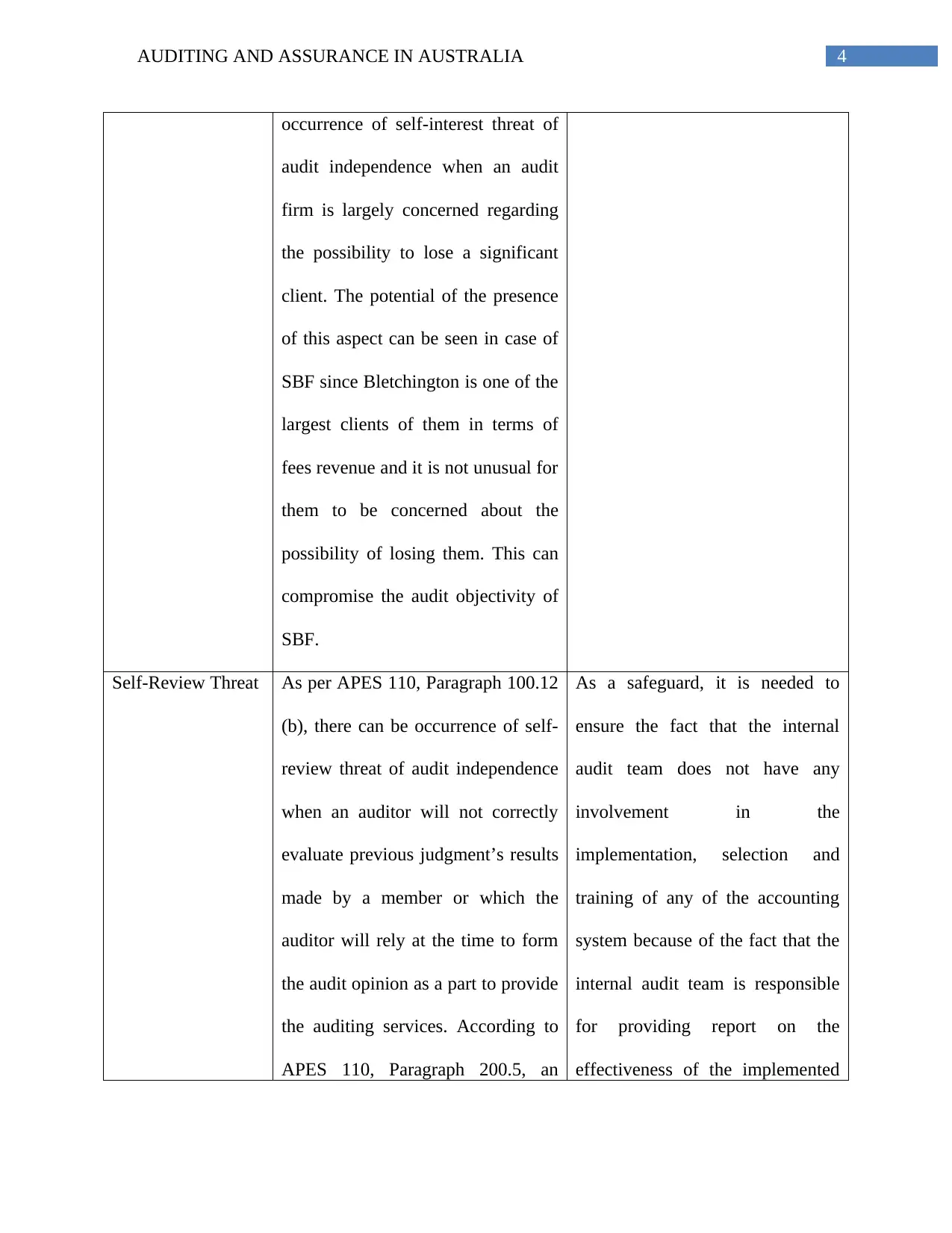
4AUDITING AND ASSURANCE IN AUSTRALIA
occurrence of self-interest threat of
audit independence when an audit
firm is largely concerned regarding
the possibility to lose a significant
client. The potential of the presence
of this aspect can be seen in case of
SBF since Bletchington is one of the
largest clients of them in terms of
fees revenue and it is not unusual for
them to be concerned about the
possibility of losing them. This can
compromise the audit objectivity of
SBF.
Self-Review Threat As per APES 110, Paragraph 100.12
(b), there can be occurrence of self-
review threat of audit independence
when an auditor will not correctly
evaluate previous judgment’s results
made by a member or which the
auditor will rely at the time to form
the audit opinion as a part to provide
the auditing services. According to
APES 110, Paragraph 200.5, an
As a safeguard, it is needed to
ensure the fact that the internal
audit team does not have any
involvement in the
implementation, selection and
training of any of the accounting
system because of the fact that the
internal audit team is responsible
for providing report on the
effectiveness of the implemented
occurrence of self-interest threat of
audit independence when an audit
firm is largely concerned regarding
the possibility to lose a significant
client. The potential of the presence
of this aspect can be seen in case of
SBF since Bletchington is one of the
largest clients of them in terms of
fees revenue and it is not unusual for
them to be concerned about the
possibility of losing them. This can
compromise the audit objectivity of
SBF.
Self-Review Threat As per APES 110, Paragraph 100.12
(b), there can be occurrence of self-
review threat of audit independence
when an auditor will not correctly
evaluate previous judgment’s results
made by a member or which the
auditor will rely at the time to form
the audit opinion as a part to provide
the auditing services. According to
APES 110, Paragraph 200.5, an
As a safeguard, it is needed to
ensure the fact that the internal
audit team does not have any
involvement in the
implementation, selection and
training of any of the accounting
system because of the fact that the
internal audit team is responsible
for providing report on the
effectiveness of the implemented
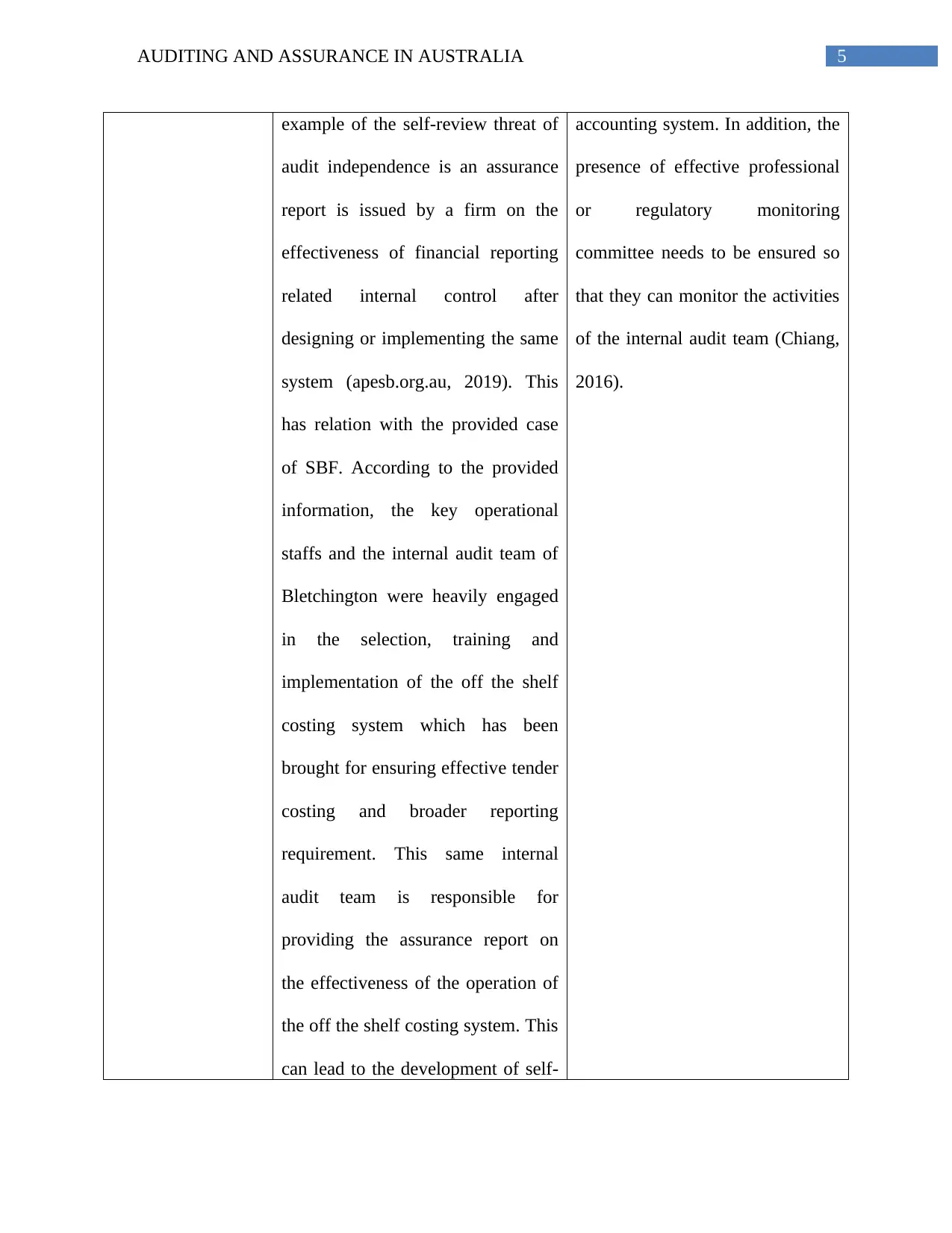
5AUDITING AND ASSURANCE IN AUSTRALIA
example of the self-review threat of
audit independence is an assurance
report is issued by a firm on the
effectiveness of financial reporting
related internal control after
designing or implementing the same
system (apesb.org.au, 2019). This
has relation with the provided case
of SBF. According to the provided
information, the key operational
staffs and the internal audit team of
Bletchington were heavily engaged
in the selection, training and
implementation of the off the shelf
costing system which has been
brought for ensuring effective tender
costing and broader reporting
requirement. This same internal
audit team is responsible for
providing the assurance report on
the effectiveness of the operation of
the off the shelf costing system. This
can lead to the development of self-
accounting system. In addition, the
presence of effective professional
or regulatory monitoring
committee needs to be ensured so
that they can monitor the activities
of the internal audit team (Chiang,
2016).
example of the self-review threat of
audit independence is an assurance
report is issued by a firm on the
effectiveness of financial reporting
related internal control after
designing or implementing the same
system (apesb.org.au, 2019). This
has relation with the provided case
of SBF. According to the provided
information, the key operational
staffs and the internal audit team of
Bletchington were heavily engaged
in the selection, training and
implementation of the off the shelf
costing system which has been
brought for ensuring effective tender
costing and broader reporting
requirement. This same internal
audit team is responsible for
providing the assurance report on
the effectiveness of the operation of
the off the shelf costing system. This
can lead to the development of self-
accounting system. In addition, the
presence of effective professional
or regulatory monitoring
committee needs to be ensured so
that they can monitor the activities
of the internal audit team (Chiang,
2016).
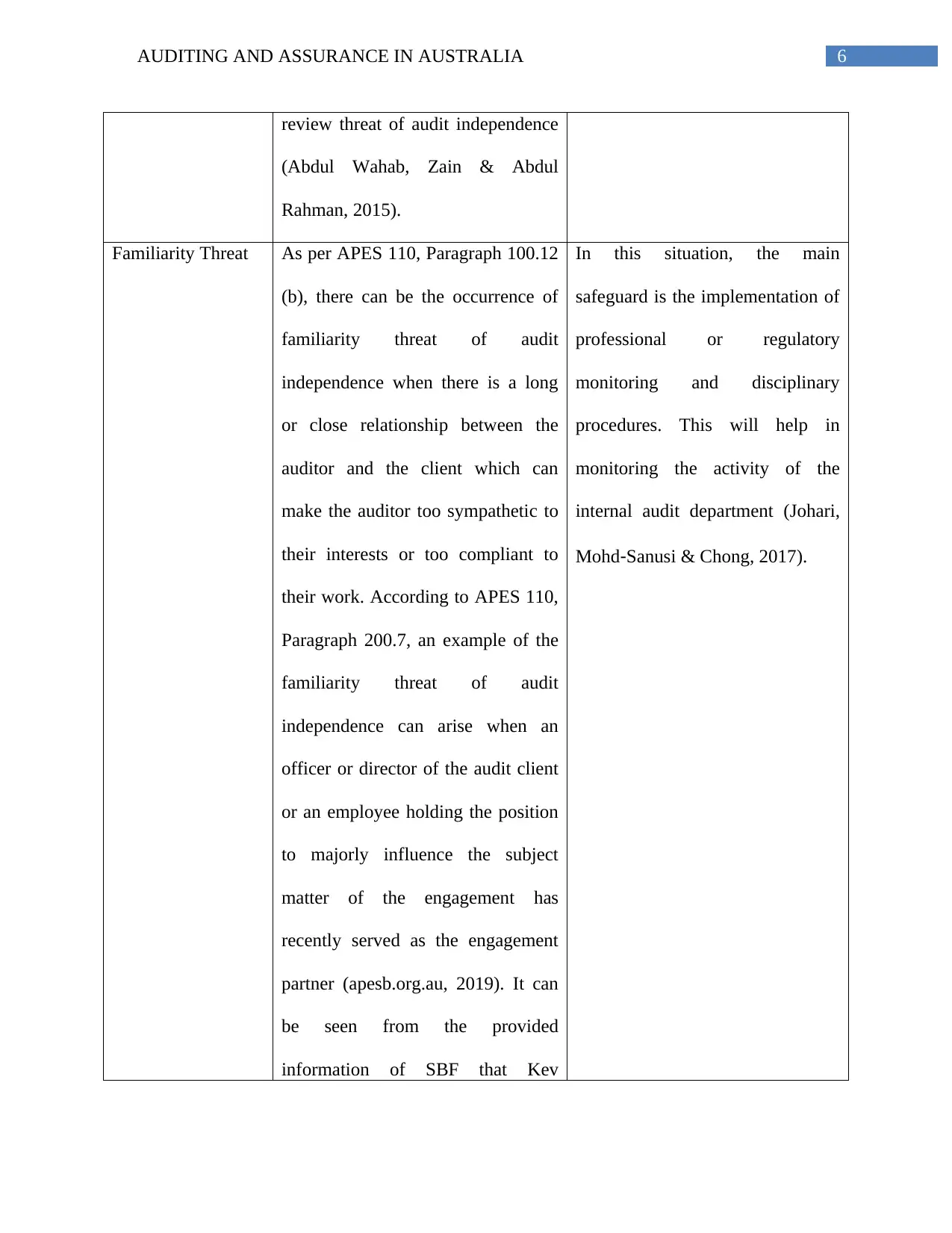
6AUDITING AND ASSURANCE IN AUSTRALIA
review threat of audit independence
(Abdul Wahab, Zain & Abdul
Rahman, 2015).
Familiarity Threat As per APES 110, Paragraph 100.12
(b), there can be the occurrence of
familiarity threat of audit
independence when there is a long
or close relationship between the
auditor and the client which can
make the auditor too sympathetic to
their interests or too compliant to
their work. According to APES 110,
Paragraph 200.7, an example of the
familiarity threat of audit
independence can arise when an
officer or director of the audit client
or an employee holding the position
to majorly influence the subject
matter of the engagement has
recently served as the engagement
partner (apesb.org.au, 2019). It can
be seen from the provided
information of SBF that Kev
In this situation, the main
safeguard is the implementation of
professional or regulatory
monitoring and disciplinary
procedures. This will help in
monitoring the activity of the
internal audit department (Johari,
Mohd‐Sanusi & Chong, 2017).
review threat of audit independence
(Abdul Wahab, Zain & Abdul
Rahman, 2015).
Familiarity Threat As per APES 110, Paragraph 100.12
(b), there can be the occurrence of
familiarity threat of audit
independence when there is a long
or close relationship between the
auditor and the client which can
make the auditor too sympathetic to
their interests or too compliant to
their work. According to APES 110,
Paragraph 200.7, an example of the
familiarity threat of audit
independence can arise when an
officer or director of the audit client
or an employee holding the position
to majorly influence the subject
matter of the engagement has
recently served as the engagement
partner (apesb.org.au, 2019). It can
be seen from the provided
information of SBF that Kev
In this situation, the main
safeguard is the implementation of
professional or regulatory
monitoring and disciplinary
procedures. This will help in
monitoring the activity of the
internal audit department (Johari,
Mohd‐Sanusi & Chong, 2017).
Paraphrase This Document
Need a fresh take? Get an instant paraphrase of this document with our AI Paraphraser
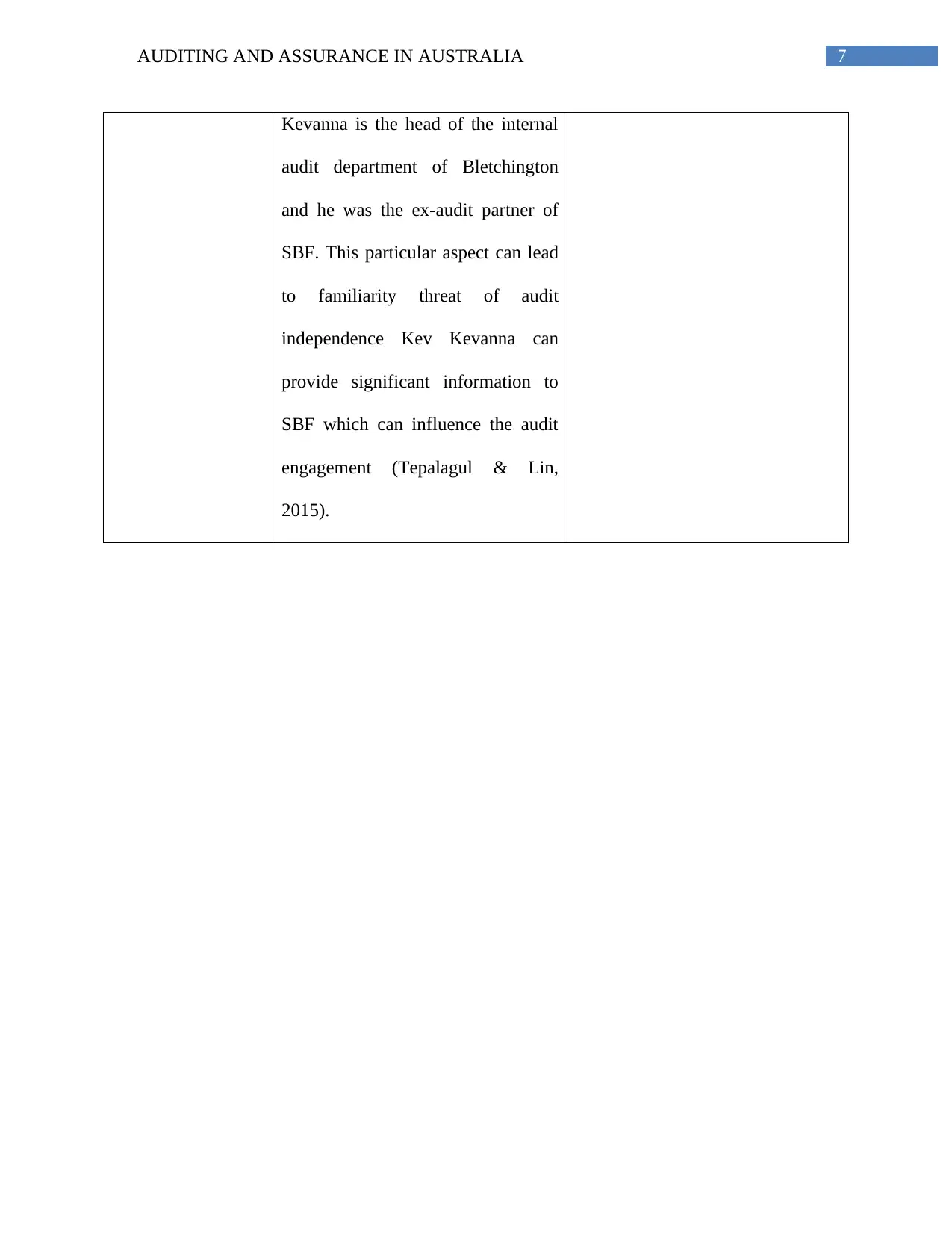
7AUDITING AND ASSURANCE IN AUSTRALIA
Kevanna is the head of the internal
audit department of Bletchington
and he was the ex-audit partner of
SBF. This particular aspect can lead
to familiarity threat of audit
independence Kev Kevanna can
provide significant information to
SBF which can influence the audit
engagement (Tepalagul & Lin,
2015).
Kevanna is the head of the internal
audit department of Bletchington
and he was the ex-audit partner of
SBF. This particular aspect can lead
to familiarity threat of audit
independence Kev Kevanna can
provide significant information to
SBF which can influence the audit
engagement (Tepalagul & Lin,
2015).
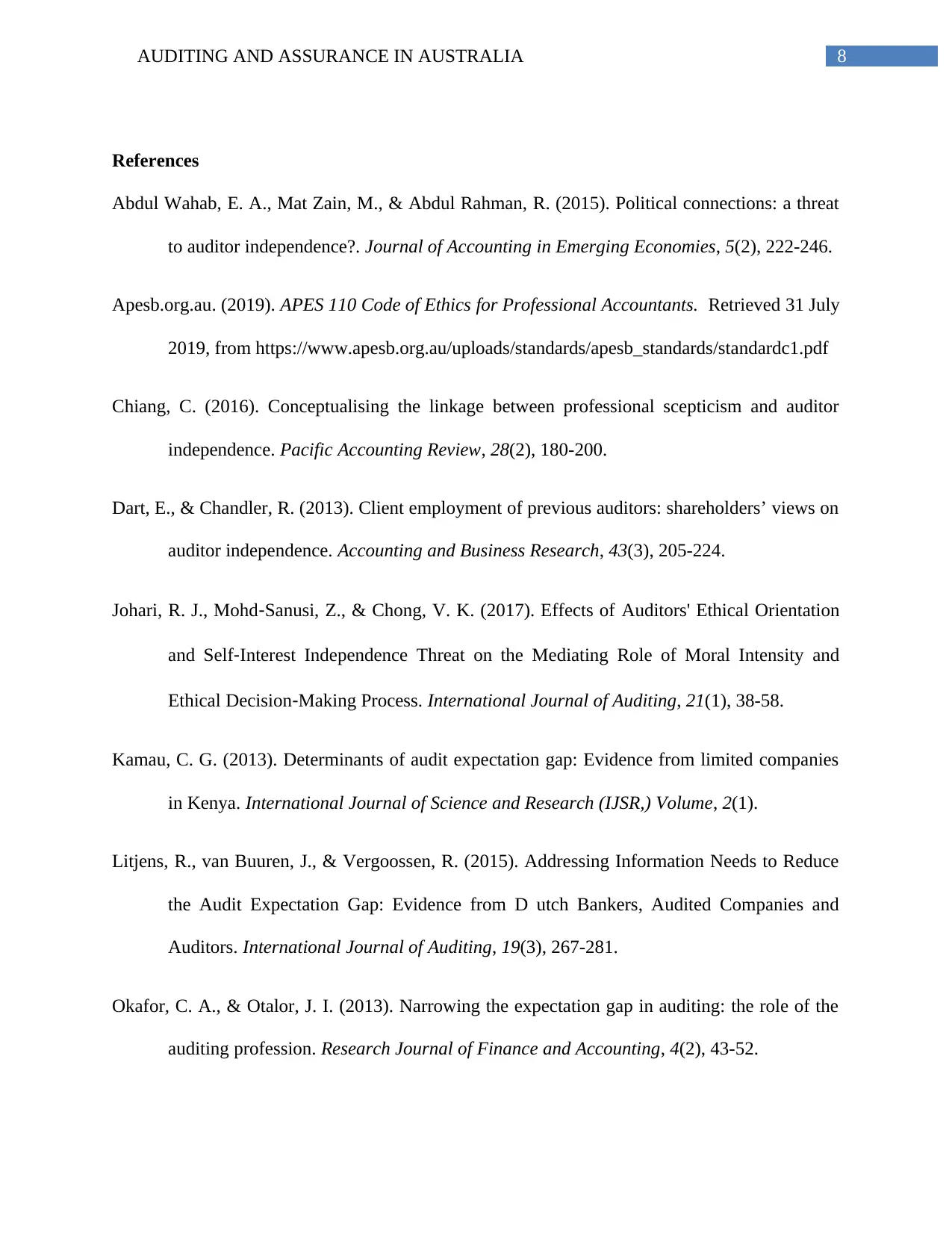
8AUDITING AND ASSURANCE IN AUSTRALIA
References
Abdul Wahab, E. A., Mat Zain, M., & Abdul Rahman, R. (2015). Political connections: a threat
to auditor independence?. Journal of Accounting in Emerging Economies, 5(2), 222-246.
Apesb.org.au. (2019). APES 110 Code of Ethics for Professional Accountants. Retrieved 31 July
2019, from https://www.apesb.org.au/uploads/standards/apesb_standards/standardc1.pdf
Chiang, C. (2016). Conceptualising the linkage between professional scepticism and auditor
independence. Pacific Accounting Review, 28(2), 180-200.
Dart, E., & Chandler, R. (2013). Client employment of previous auditors: shareholders’ views on
auditor independence. Accounting and Business Research, 43(3), 205-224.
Johari, R. J., Mohd‐Sanusi, Z., & Chong, V. K. (2017). Effects of Auditors' Ethical Orientation
and Self‐Interest Independence Threat on the Mediating Role of Moral Intensity and
Ethical Decision‐Making Process. International Journal of Auditing, 21(1), 38-58.
Kamau, C. G. (2013). Determinants of audit expectation gap: Evidence from limited companies
in Kenya. International Journal of Science and Research (IJSR,) Volume, 2(1).
Litjens, R., van Buuren, J., & Vergoossen, R. (2015). Addressing Information Needs to Reduce
the Audit Expectation Gap: Evidence from D utch Bankers, Audited Companies and
Auditors. International Journal of Auditing, 19(3), 267-281.
Okafor, C. A., & Otalor, J. I. (2013). Narrowing the expectation gap in auditing: the role of the
auditing profession. Research Journal of Finance and Accounting, 4(2), 43-52.
References
Abdul Wahab, E. A., Mat Zain, M., & Abdul Rahman, R. (2015). Political connections: a threat
to auditor independence?. Journal of Accounting in Emerging Economies, 5(2), 222-246.
Apesb.org.au. (2019). APES 110 Code of Ethics for Professional Accountants. Retrieved 31 July
2019, from https://www.apesb.org.au/uploads/standards/apesb_standards/standardc1.pdf
Chiang, C. (2016). Conceptualising the linkage between professional scepticism and auditor
independence. Pacific Accounting Review, 28(2), 180-200.
Dart, E., & Chandler, R. (2013). Client employment of previous auditors: shareholders’ views on
auditor independence. Accounting and Business Research, 43(3), 205-224.
Johari, R. J., Mohd‐Sanusi, Z., & Chong, V. K. (2017). Effects of Auditors' Ethical Orientation
and Self‐Interest Independence Threat on the Mediating Role of Moral Intensity and
Ethical Decision‐Making Process. International Journal of Auditing, 21(1), 38-58.
Kamau, C. G. (2013). Determinants of audit expectation gap: Evidence from limited companies
in Kenya. International Journal of Science and Research (IJSR,) Volume, 2(1).
Litjens, R., van Buuren, J., & Vergoossen, R. (2015). Addressing Information Needs to Reduce
the Audit Expectation Gap: Evidence from D utch Bankers, Audited Companies and
Auditors. International Journal of Auditing, 19(3), 267-281.
Okafor, C. A., & Otalor, J. I. (2013). Narrowing the expectation gap in auditing: the role of the
auditing profession. Research Journal of Finance and Accounting, 4(2), 43-52.
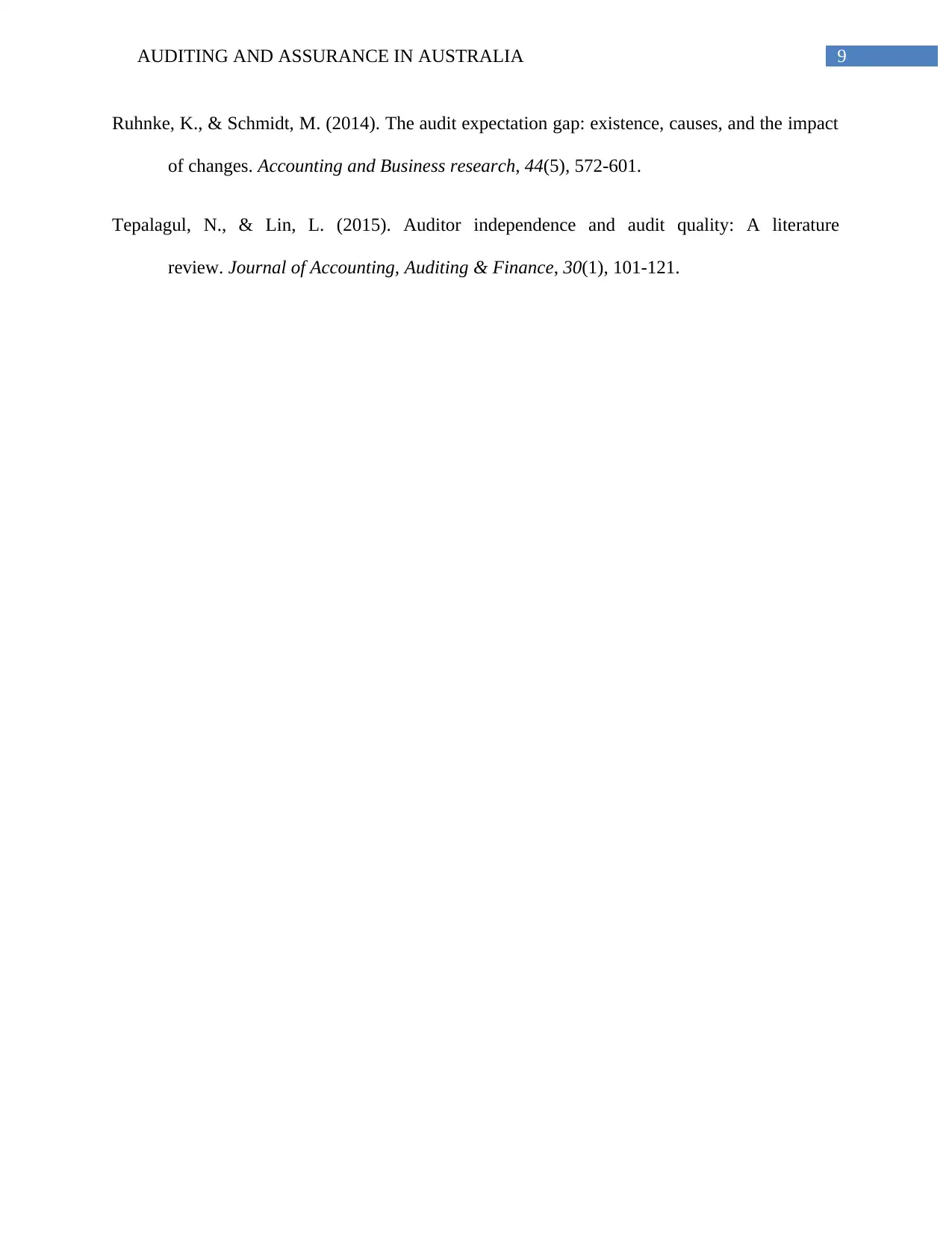
9AUDITING AND ASSURANCE IN AUSTRALIA
Ruhnke, K., & Schmidt, M. (2014). The audit expectation gap: existence, causes, and the impact
of changes. Accounting and Business research, 44(5), 572-601.
Tepalagul, N., & Lin, L. (2015). Auditor independence and audit quality: A literature
review. Journal of Accounting, Auditing & Finance, 30(1), 101-121.
Ruhnke, K., & Schmidt, M. (2014). The audit expectation gap: existence, causes, and the impact
of changes. Accounting and Business research, 44(5), 572-601.
Tepalagul, N., & Lin, L. (2015). Auditor independence and audit quality: A literature
review. Journal of Accounting, Auditing & Finance, 30(1), 101-121.
1 out of 10
Related Documents
Your All-in-One AI-Powered Toolkit for Academic Success.
+13062052269
info@desklib.com
Available 24*7 on WhatsApp / Email
![[object Object]](/_next/static/media/star-bottom.7253800d.svg)
Unlock your academic potential
© 2024 | Zucol Services PVT LTD | All rights reserved.





